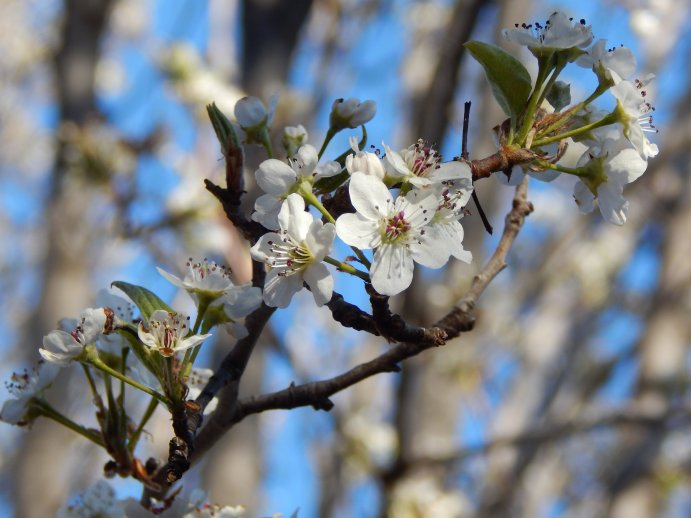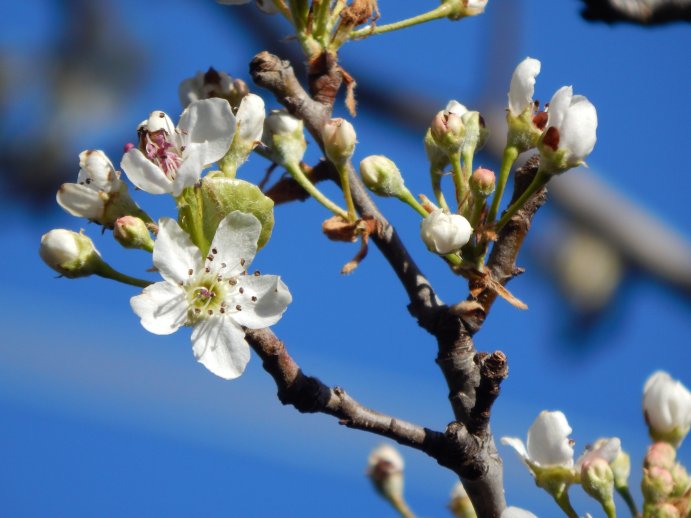
The Bradford Pear (Pyrus calleryana) is not now and never will be my favorite tree. When in bloom at this time of year, as the ones in my yard currently are, it’s a beautiful tree. Unfortunately, along with the blooms comes an odor reminiscent of rotting fish. Around here the smell doesn’t really last that long — gusty winds or a stray downpour will quite frequently destroy the blooms and create a mat of white petals beneath the trees — but while it lasts it is quite pungent.

You may ask why anyone would want to plant a tree that smells like dead fish while blooming. And that’s a very good question! Bradford Pears were the “in” tree in this part of the country, and probably many other regions as well, for a number of years. When new housing developments were built some of the first trees the builders plunked into the ground were Bradford Pears. When old trees died in an established landscape Bradford Pears were often brought in to replace them. Why? Well, there are some positives about planting these trees:
- Bradford Pears produce beautiful white blooms in the spring and their leaves offer wonderful orange, red and purple autumn colors.
- At 25-30 feet tall, with a canopy of 20-25 feet, they’re a medium-sized tree that can fit in many landscape areas.
- The trees have a very symmetrical shape.
- There are virtually no pests or diseases that affect them.
- Bradford Pear trees are fast growers.
- They’re inexpensive to purchase.
But the negatives far outweigh the positives when it comes to the Bradford Pear. For example:
- Bradford Pears are structurally weak trees, making them susceptible to damage from high winds and ice storms.
- They look very fragile and are very fragile trees.
- The lifespan of these trees is usually less than 25 years.
- Bradford Pears form small, berry-like fruits that cover the ground once they begin falling.
- It’s very difficult to grow grass or any other plants beneath these trees.
- The trees can become invasive for various reasons.
- They become very lanky and unattractive with age, and pruning them doesn’t really help.
There are quite a few Bradford Pears in our neighborhood. The younger trees still have a very nice appearance, but the older specimens are looking a bit tired! Many have been heavily pruned due to wind damage or because the tops of their branches have become too weighty for the tree to support. Some have broken or dead limbs. Before long many of these trees will die and have to be removed. Will they be replaced with trees of the same type? I hope not!
We have several Bradford Pears in our yard and they’re gradually fading away. Though I’ll admit to having a love-hate relationship with them, they’ll be the last of their kind in our landscape. And that’s really a shame when I think about it, because in their prime they really are lovely little trees.
Hear, hear! Thanks for speaking the truth about this impostor tree. Whoever thought this was a good idea? It speaks of that “knock-em-up for quick sale” ethos that seems to be the new American ethic of instant gratification. Give me solid and grounded hardwoods please! 🙂
LikeLiked by 1 person
I couldn’t agree with you more. Your image of instant gratification is so very true. I know we all want trees — and other plants — that will mature with the snap of our fingers. Unfortunately those plants aren’t usually the ones that will be in our yards and gardens for the duration. The previous owners of our home planted the Bradford Pears we now have, I’m sure, as a divider in the side-lawn, between our house and the neighbors. And that’s fine. But the trees are now over 20 years old and are noticeably no longer in their prime.
LikeLiked by 1 person
I disagree. I think the positives outnumber the negatives. I love the Bradford Pear in our front yard and up and down our residential street here in NW Austin. Of course, we don’t have the icing or high winds that Dallas would encounter. They do require annual trimming to lower branches, but the bloom in spring and fall color, plus rich green foliage throughout summer, and even the fuzzy buds in winter are ornamental features that can’t be overlooked. I think this tree gets a really bad and undeserved rap.
LikeLike
I can certainly understand your love for your tree. I feel much the same way about others in our yard. I think the Bradford Pear in full bloom is a beautiful tree and I agree with you about the fuzzy buds! But due to the experience we’ve had with them — an experience shared by many others we know — I wouldn’t plant one again. Perhaps they do well in your part of the state, but they don’t have a great quantity or quality of life in this area! I’ve actually not seen them sold in the immediate area recently (though they may still be through Lowe’s or Home Depot) probably because they don’t do real well in drought conditions. Thanks for your thoughts on this tree.
LikeLike
I think if I wanted a fruit tree fro Austin I would probably go for a Mexican Plum rather than the Bradford Pear. The Mexican Plums that grow near me have beautiful spring blossoms and really delicious fruits you can eat out of hand. Or the Texas Persimmon. Both are tough, beautiful and drought tolerant.
LikeLike
That certainly looks to be a great choice and the blooms resemble those of the Bradford Pear. I’m sure the birds love the fruit. And I love Persimmon trees! I certainly don’t look to plant trees anytime soon but those are great suggestions for anyone who is.
LikeLiked by 1 person
I only wish I had room to plant either.
LikeLike
Same here!
LikeLike
I think the Bradford pear was an ‘it’ tree around the globe – I see them everywhere in Sydney, and they are even planted here in the mountains, although, with snow and high winds, they don’t last too long. In Sydney, they tend to get quite lanky and misshapen, so I understand why they are not on your must-have list 🙂
LikeLike
I guess they’ve been popular everywhere! I wonder how that came about? They do have problems with high winds. Our neighbors had a quite large one in their backyard which was split in half by the wind several years ago.
LikeLike
On the face of it they do look a lovely tree from your photos, especially when it is in blossom. Weater it’s good or bad, it’s better than no trees at all.
Amanda xx
LikeLike
The blossoms are beautiful!
LikeLike
Interesting post, and comments. I see that it’s actually a native of China and Vietnam, and certainly doesn’t appear to be common here in the UK. xx
LikeLike
Yes, I remember reading somewhere that they come originally from China and Vietnam. An interesting type of export to say the least!
LikeLike
Bradford pears are gorgeous when viewed from the street (where the aroma is not part of the experience), but I agree with Debra. I realize using non-native trees often means an absence of pests but if I wanted a blooming tree I’d go with a native fruit tree. They are every bit as lovely to my eyes and weirdly, less commonplace here in Texas!
LikeLike
I agree!
LikeLike
I work for a Tree Pruning Service company and I too have to totally agree with you. Definitely NOT MY FAVORITE TREE!
LikeLike
Thanks for your comment! I hope that’s not you at the very top of that tree on the homepage of your website!
LikeLiked by 1 person
When I first saw these blooming my first spring in Texas I thought: so many fruit trees! Finally a suburban tree tradition to feed people!
Then I heard they were pear trees. They didn’t look like any pear tree I knew, but oh well, surely the pears would be delicious…
Yeah. They make great shade and beautiful blossoms and foliage in the fall, but they do require quite the careful pruning. And maybe I’m just lucky, but they don’t smell like rotting fish (or anything) to my nose.
LikeLike
How funny! But how true. When you hear the term “pear tree” you naturally think about pears. Real pears. Lucky you that you’ve evaded the smell! Sometimes it gets pretty bad, at other times its hardly noticeable.
LikeLike
The blossom is so pretty but I’ m not sure I would want a tree that smells like rotting fish. Yuck!
LikeLike
I suppose a lot of plants have there drawbacks!
LikeLike
It is a pity they didn’t plant a more useful pear tree, their blossom is wonderful, almost like a rose.
I posted a picture from one of our pear trees in blossom in my ‘Trees’ blog. it is one of my favourite trees in the garden, with nice pears to eat as well!
LikeLike
The birds and squirrels would probably eat anything more useful! 🙂 It would be nice to have a good pear tree that actually produced something edible, though!
LikeLike
We are required to have one smack-dap in the middle of every front yard in our neighborhood. They are all around 20 yrs old now and starting to break and die. Ugh. All but a few homeowners want to get rid of them. They can be pretty but they really do stink when they bloom. Most arealso getting all kinds of ‘suckers’. What do we do about those?!
LikeLike
Ours have had branches dying off each year for the past 4-5 years. My husband will have to get out sometime this spring and trim some back. The trees overall have become very lanky and droopy, although when flowering they’re still beautiful. As for the suckers, we just snip them to the ground or prune them off the trunk. There’s not much more you can do!
LikeLike